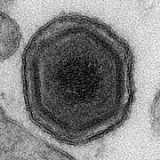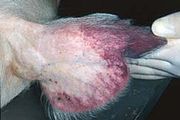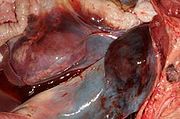
African swine fever virus
Encyclopedia
African swine fever virus (ASFV) is the causative agent of African swine fever (ASF). ASFV is a large, double-stranded DNA
virus which replicates in the cytoplasm
of infected cells, and is the only member of the Asfarviridae
family. ASFV infects domestic pigs
, warthogs and bushpigs, as well as soft ticks (Ornithodoros
), which are likely vectors. ASFV is the only virus with a DNA genome transmitted by arthropods. The virus causes a lethal haemorraghic disease in domestic pigs. Some isolates can cause death of animals within as little as a week after infection. In all other species, the virus causes no obvious disease. ASFV is endemic to sub-Saharan Africa
and exists in the wild through a cycle of infection between ticks and wild pigs, bushpigs and warthogs. ASFV was first described after European settlers brought pigs into areas endemic with ASFV and, as such, is an example of an 'emerging infection'.
, Portugal
. A further outbreak occurred there in 1960. Subsequent to these initial introductions, the disease became established in the Iberian peninsula and sporadic outbreaks occurred in France
, Belgium
and other European countries during the 1980s. Both Spain
and Portugal
had managed to eradicate the disease by the mid 1990s through a slaughter policy. During the late 1970s, ASFV crossed the Atlantic Ocean
and outbreaks were reported in some Caribbean islands, including Cuba
and the Dominican Republic
. Major outbreaks of ASF in Africa are regularly reported to the World Organisation for Animal Health (previously called l'office international des épizooties (OIE)). The most recent outbreak of ASF outside Africa started at the beginning of 2007 in Georgia
, and has since spread to the countries of Armenia
, Azerbaijan
, Iran
and Russia
.
The appearance of ASF in the Western hemisphere at the same time as the emergence of AIDS
led to some interest in whether the two were related, and a report appeared in the Lancet supporting this in 1986. However, AIDS
is now known to be caused by human immunodeficiency virus (HIV
); no link between ASFV and AIDS has been proven or is suspected.
 The clinical symptoms of ASF are very similar to classical swine fever virus, and the two diseases normally have to be distinguished by laboratory diagnosis.
The clinical symptoms of ASF are very similar to classical swine fever virus, and the two diseases normally have to be distinguished by laboratory diagnosis.

 ASFV is a large, double-stranded DNA
ASFV is a large, double-stranded DNA
virus
with a genome
containing at least 150 genes. The number of genes differs slightly between different isolates of the virus. ASFV has similarities to the other large DNA viruses, e.g., poxvirus, iridovirus and mimivirus
. In common with other viral haemorrhagic fevers, the main target cells for replication are those of monocyte
, macrophage
lineage. The virus causes a haemorrhagic fever with high mortality rates in pigs, but persistently infects its natural hosts, warthogs, bushpigs and soft ticks of the Ornithodoros
genus, with no disease signs. The virus encodes enzymes required for replication and transcription of the genome, including elements of a base excision repair system, structural proteins and many proteins that are not essential for replication in cells, but have roles in virus survival and transmission in its hosts. Virus replication takes place in perinuclear factory areas. Assembly of the icosahedral capsid
occurs on modified membranes from the endoplasmic reticulum
. Products from proteolytically-processed polyproteins form the core shell between the internal membrane and the nucleoprotein
core. An additional outer membrane is gained as particles bud from the plasma membrane. The virus encodes proteins that inhibit signalling pathways in infected macrophages and thus modulate transcriptional activation of immune response genes. In addition, the virus encodes proteins which inhibit apoptosis
of infected cells to facilitate production of progeny virions. Viral membrane proteins with similarity to cellular adhesion proteins modulate interaction of virus-infected cells and extracellular virions with host components.
DNA
Deoxyribonucleic acid is a nucleic acid that contains the genetic instructions used in the development and functioning of all known living organisms . The DNA segments that carry this genetic information are called genes, but other DNA sequences have structural purposes, or are involved in...
virus which replicates in the cytoplasm
Cytoplasm
The cytoplasm is a small gel-like substance residing between the cell membrane holding all the cell's internal sub-structures , except for the nucleus. All the contents of the cells of prokaryote organisms are contained within the cytoplasm...
of infected cells, and is the only member of the Asfarviridae
Asfarviridae
Asfarviridae is a family of viruses that primarily infects swine, resulting in an onset of African swine fever. There is a single genus in this family: Asfivirus. The name of this family and genus are derived from the acronym: African swine fever and related viruses...
family. ASFV infects domestic pigs
PIGS
PIGS is a four letter acronym that can stand for:* PIGS , Phosphatidylinositol glycan anchor biosynthesis, class S, a human gene* PIGS , the economies of Portugal, Italy , Greece and Spain...
, warthogs and bushpigs, as well as soft ticks (Ornithodoros
Ornithodoros
Ornithodoros is a genus in the soft-bodied tick family, Argasidae. The Linnean name derives from ornithos and doros , meaning "bird" and "gift," respectively...
), which are likely vectors. ASFV is the only virus with a DNA genome transmitted by arthropods. The virus causes a lethal haemorraghic disease in domestic pigs. Some isolates can cause death of animals within as little as a week after infection. In all other species, the virus causes no obvious disease. ASFV is endemic to sub-Saharan Africa
Sub-Saharan Africa
Sub-Saharan Africa as a geographical term refers to the area of the African continent which lies south of the Sahara. A political definition of Sub-Saharan Africa, instead, covers all African countries which are fully or partially located south of the Sahara...
and exists in the wild through a cycle of infection between ticks and wild pigs, bushpigs and warthogs. ASFV was first described after European settlers brought pigs into areas endemic with ASFV and, as such, is an example of an 'emerging infection'.
History
African swine fever was restricted to the continent that bears its name until 1957, when the disease was reported in LisbonLisbon
Lisbon is the capital city and largest city of Portugal with a population of 545,245 within its administrative limits on a land area of . The urban area of Lisbon extends beyond the administrative city limits with a population of 3 million on an area of , making it the 9th most populous urban...
, Portugal
Portugal
Portugal , officially the Portuguese Republic is a country situated in southwestern Europe on the Iberian Peninsula. Portugal is the westernmost country of Europe, and is bordered by the Atlantic Ocean to the West and South and by Spain to the North and East. The Atlantic archipelagos of the...
. A further outbreak occurred there in 1960. Subsequent to these initial introductions, the disease became established in the Iberian peninsula and sporadic outbreaks occurred in France
France
The French Republic , The French Republic , The French Republic , (commonly known as France , is a unitary semi-presidential republic in Western Europe with several overseas territories and islands located on other continents and in the Indian, Pacific, and Atlantic oceans. Metropolitan France...
, Belgium
Belgium
Belgium , officially the Kingdom of Belgium, is a federal state in Western Europe. It is a founding member of the European Union and hosts the EU's headquarters, and those of several other major international organisations such as NATO.Belgium is also a member of, or affiliated to, many...
and other European countries during the 1980s. Both Spain
Spain
Spain , officially the Kingdom of Spain languages]] under the European Charter for Regional or Minority Languages. In each of these, Spain's official name is as follows:;;;;;;), is a country and member state of the European Union located in southwestern Europe on the Iberian Peninsula...
and Portugal
Portugal
Portugal , officially the Portuguese Republic is a country situated in southwestern Europe on the Iberian Peninsula. Portugal is the westernmost country of Europe, and is bordered by the Atlantic Ocean to the West and South and by Spain to the North and East. The Atlantic archipelagos of the...
had managed to eradicate the disease by the mid 1990s through a slaughter policy. During the late 1970s, ASFV crossed the Atlantic Ocean
Atlantic Ocean
The Atlantic Ocean is the second-largest of the world's oceanic divisions. With a total area of about , it covers approximately 20% of the Earth's surface and about 26% of its water surface area...
and outbreaks were reported in some Caribbean islands, including Cuba
Cuba
The Republic of Cuba is an island nation in the Caribbean. The nation of Cuba consists of the main island of Cuba, the Isla de la Juventud, and several archipelagos. Havana is the largest city in Cuba and the country's capital. Santiago de Cuba is the second largest city...
and the Dominican Republic
Dominican Republic
The Dominican Republic is a nation on the island of La Hispaniola, part of the Greater Antilles archipelago in the Caribbean region. The western third of the island is occupied by the nation of Haiti, making Hispaniola one of two Caribbean islands that are shared by two countries...
. Major outbreaks of ASF in Africa are regularly reported to the World Organisation for Animal Health (previously called l'office international des épizooties (OIE)). The most recent outbreak of ASF outside Africa started at the beginning of 2007 in Georgia
Georgia (country)
Georgia is a sovereign state in the Caucasus region of Eurasia. Located at the crossroads of Western Asia and Eastern Europe, it is bounded to the west by the Black Sea, to the north by Russia, to the southwest by Turkey, to the south by Armenia, and to the southeast by Azerbaijan. The capital of...
, and has since spread to the countries of Armenia
Armenia
Armenia , officially the Republic of Armenia , is a landlocked mountainous country in the Caucasus region of Eurasia...
, Azerbaijan
Azerbaijan
Azerbaijan , officially the Republic of Azerbaijan is the largest country in the Caucasus region of Eurasia. Located at the crossroads of Western Asia and Eastern Europe, it is bounded by the Caspian Sea to the east, Russia to the north, Georgia to the northwest, Armenia to the west, and Iran to...
, Iran
Iran
Iran , officially the Islamic Republic of Iran , is a country in Southern and Western Asia. The name "Iran" has been in use natively since the Sassanian era and came into use internationally in 1935, before which the country was known to the Western world as Persia...
and Russia
Russia
Russia or , officially known as both Russia and the Russian Federation , is a country in northern Eurasia. It is a federal semi-presidential republic, comprising 83 federal subjects...
.
The appearance of ASF in the Western hemisphere at the same time as the emergence of AIDS
AIDS
Acquired immune deficiency syndrome or acquired immunodeficiency syndrome is a disease of the human immune system caused by the human immunodeficiency virus...
led to some interest in whether the two were related, and a report appeared in the Lancet supporting this in 1986. However, AIDS
AIDS
Acquired immune deficiency syndrome or acquired immunodeficiency syndrome is a disease of the human immune system caused by the human immunodeficiency virus...
is now known to be caused by human immunodeficiency virus (HIV
HIV
Human immunodeficiency virus is a lentivirus that causes acquired immunodeficiency syndrome , a condition in humans in which progressive failure of the immune system allows life-threatening opportunistic infections and cancers to thrive...
); no link between ASFV and AIDS has been proven or is suspected.
Symptoms


Virus structure and replication

DNA
Deoxyribonucleic acid is a nucleic acid that contains the genetic instructions used in the development and functioning of all known living organisms . The DNA segments that carry this genetic information are called genes, but other DNA sequences have structural purposes, or are involved in...
virus
Virus
A virus is a small infectious agent that can replicate only inside the living cells of organisms. Viruses infect all types of organisms, from animals and plants to bacteria and archaea...
with a genome
Genome
In modern molecular biology and genetics, the genome is the entirety of an organism's hereditary information. It is encoded either in DNA or, for many types of virus, in RNA. The genome includes both the genes and the non-coding sequences of the DNA/RNA....
containing at least 150 genes. The number of genes differs slightly between different isolates of the virus. ASFV has similarities to the other large DNA viruses, e.g., poxvirus, iridovirus and mimivirus
Mimivirus
Mimivirus is a viral genus containing a single identified species named Acanthamoeba polyphaga mimivirus , or is a group of phylogenetically related large viruses . In colloquial speech, APMV is more commonly referred to as just “mimivirus”...
. In common with other viral haemorrhagic fevers, the main target cells for replication are those of monocyte
Monocyte
Monocytes are a type of white blood cell and are part of the innate immune system of vertebrates including all mammals , birds, reptiles, and fish. Monocytes play multiple roles in immune function...
, macrophage
Macrophage
Macrophages are cells produced by the differentiation of monocytes in tissues. Human macrophages are about in diameter. Monocytes and macrophages are phagocytes. Macrophages function in both non-specific defense as well as help initiate specific defense mechanisms of vertebrate animals...
lineage. The virus causes a haemorrhagic fever with high mortality rates in pigs, but persistently infects its natural hosts, warthogs, bushpigs and soft ticks of the Ornithodoros
Ornithodoros
Ornithodoros is a genus in the soft-bodied tick family, Argasidae. The Linnean name derives from ornithos and doros , meaning "bird" and "gift," respectively...
genus, with no disease signs. The virus encodes enzymes required for replication and transcription of the genome, including elements of a base excision repair system, structural proteins and many proteins that are not essential for replication in cells, but have roles in virus survival and transmission in its hosts. Virus replication takes place in perinuclear factory areas. Assembly of the icosahedral capsid
Capsid
A capsid is the protein shell of a virus. It consists of several oligomeric structural subunits made of protein called protomers. The observable 3-dimensional morphological subunits, which may or may not correspond to individual proteins, are called capsomeres. The capsid encloses the genetic...
occurs on modified membranes from the endoplasmic reticulum
Endoplasmic reticulum
The endoplasmic reticulum is an organelle of cells in eukaryotic organisms that forms an interconnected network of tubules, vesicles, and cisternae...
. Products from proteolytically-processed polyproteins form the core shell between the internal membrane and the nucleoprotein
Nucleoprotein
A nucleoprotein is any protein that is structurally associated with nucleic acid .Many viruses harness this protein, and they are known for being host-specific...
core. An additional outer membrane is gained as particles bud from the plasma membrane. The virus encodes proteins that inhibit signalling pathways in infected macrophages and thus modulate transcriptional activation of immune response genes. In addition, the virus encodes proteins which inhibit apoptosis
Apoptosis
Apoptosis is the process of programmed cell death that may occur in multicellular organisms. Biochemical events lead to characteristic cell changes and death. These changes include blebbing, cell shrinkage, nuclear fragmentation, chromatin condensation, and chromosomal DNA fragmentation...
of infected cells to facilitate production of progeny virions. Viral membrane proteins with similarity to cellular adhesion proteins modulate interaction of virus-infected cells and extracellular virions with host components.
External links
- OIE Animal Disease Data: http://www.oie.int/eng/maladies/fiches/a_A120.htm
- Institute for Animal Health Factfile: http://www.iah.ac.uk/disease/AfSwFe.shtml
- Department of Environment, Food and Rural Affairs Disease Factsheet: http://www.defra.gov.uk/animalh/diseases/notifiable/asf/index.htm
- ThePigSite.com: http://www.thepigsite.com/pighealth/article/441/african-swine-fever-asf
- CFIA Animal Disease Information
- African swine fever fact sheet
- Biosecurity training video
- Farm-level biosecurity practices

